Network Protocols, SDLC & ITSM: Analysis and Comparison
VerifiedAdded on 2022/11/15
|7
|1244
|424
Homework Assignment
AI Summary
This assignment solution addresses key concepts in network protocols, Software Development Life Cycle (SDLC), and IT Service Management (ITSM). The solution begins by calculating the total bytes sent with TCP/IP overhead using IPv4 and IPv6. It then explains the coexistence of TCP and IP protoco...

Running head: NETWORK PROTOCOLS, SDLC & ITSM
Network Protocols, SDLC & ITSM
Name of the Student
Name of the University
Author Note
Network Protocols, SDLC & ITSM
Name of the Student
Name of the University
Author Note
Paraphrase This Document
Need a fresh take? Get an instant paraphrase of this document with our AI Paraphraser
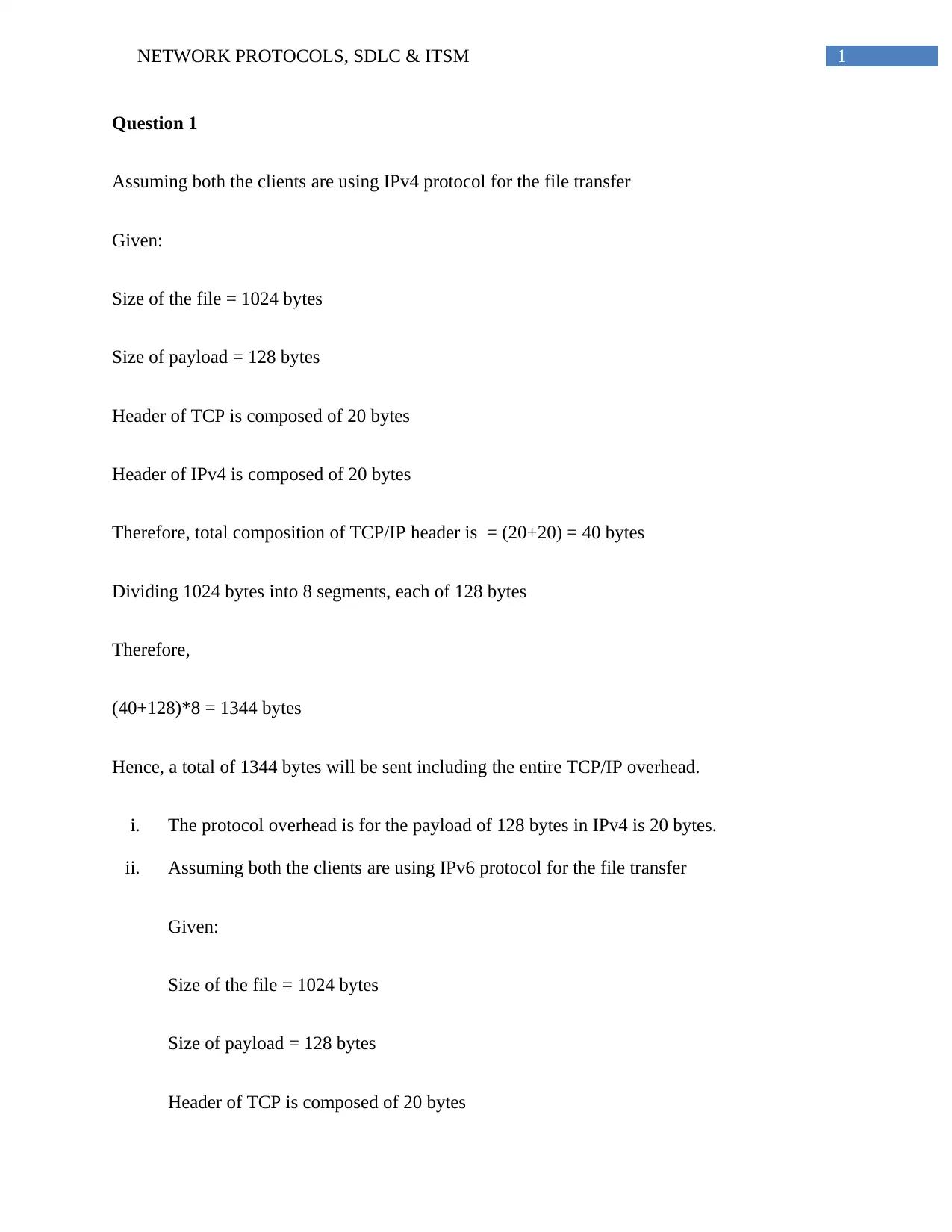
1NETWORK PROTOCOLS, SDLC & ITSM
Question 1
Assuming both the clients are using IPv4 protocol for the file transfer
Given:
Size of the file = 1024 bytes
Size of payload = 128 bytes
Header of TCP is composed of 20 bytes
Header of IPv4 is composed of 20 bytes
Therefore, total composition of TCP/IP header is = (20+20) = 40 bytes
Dividing 1024 bytes into 8 segments, each of 128 bytes
Therefore,
(40+128)*8 = 1344 bytes
Hence, a total of 1344 bytes will be sent including the entire TCP/IP overhead.
i. The protocol overhead is for the payload of 128 bytes in IPv4 is 20 bytes.
ii. Assuming both the clients are using IPv6 protocol for the file transfer
Given:
Size of the file = 1024 bytes
Size of payload = 128 bytes
Header of TCP is composed of 20 bytes
Question 1
Assuming both the clients are using IPv4 protocol for the file transfer
Given:
Size of the file = 1024 bytes
Size of payload = 128 bytes
Header of TCP is composed of 20 bytes
Header of IPv4 is composed of 20 bytes
Therefore, total composition of TCP/IP header is = (20+20) = 40 bytes
Dividing 1024 bytes into 8 segments, each of 128 bytes
Therefore,
(40+128)*8 = 1344 bytes
Hence, a total of 1344 bytes will be sent including the entire TCP/IP overhead.
i. The protocol overhead is for the payload of 128 bytes in IPv4 is 20 bytes.
ii. Assuming both the clients are using IPv6 protocol for the file transfer
Given:
Size of the file = 1024 bytes
Size of payload = 128 bytes
Header of TCP is composed of 20 bytes
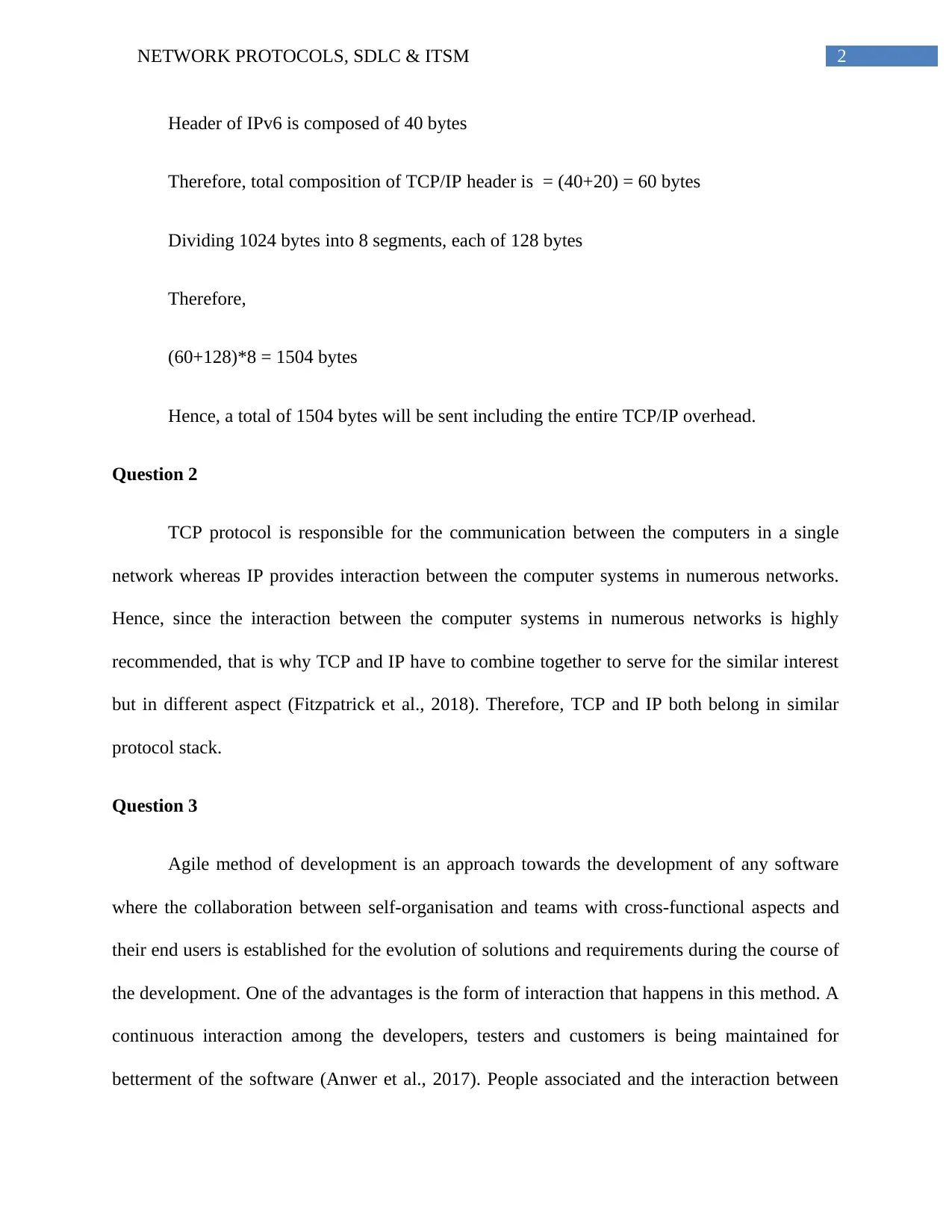
2NETWORK PROTOCOLS, SDLC & ITSM
Header of IPv6 is composed of 40 bytes
Therefore, total composition of TCP/IP header is = (40+20) = 60 bytes
Dividing 1024 bytes into 8 segments, each of 128 bytes
Therefore,
(60+128)*8 = 1504 bytes
Hence, a total of 1504 bytes will be sent including the entire TCP/IP overhead.
Question 2
TCP protocol is responsible for the communication between the computers in a single
network whereas IP provides interaction between the computer systems in numerous networks.
Hence, since the interaction between the computer systems in numerous networks is highly
recommended, that is why TCP and IP have to combine together to serve for the similar interest
but in different aspect (Fitzpatrick et al., 2018). Therefore, TCP and IP both belong in similar
protocol stack.
Question 3
Agile method of development is an approach towards the development of any software
where the collaboration between self-organisation and teams with cross-functional aspects and
their end users is established for the evolution of solutions and requirements during the course of
the development. One of the advantages is the form of interaction that happens in this method. A
continuous interaction among the developers, testers and customers is being maintained for
betterment of the software (Anwer et al., 2017). People associated and the interaction between
Header of IPv6 is composed of 40 bytes
Therefore, total composition of TCP/IP header is = (40+20) = 60 bytes
Dividing 1024 bytes into 8 segments, each of 128 bytes
Therefore,
(60+128)*8 = 1504 bytes
Hence, a total of 1504 bytes will be sent including the entire TCP/IP overhead.
Question 2
TCP protocol is responsible for the communication between the computers in a single
network whereas IP provides interaction between the computer systems in numerous networks.
Hence, since the interaction between the computer systems in numerous networks is highly
recommended, that is why TCP and IP have to combine together to serve for the similar interest
but in different aspect (Fitzpatrick et al., 2018). Therefore, TCP and IP both belong in similar
protocol stack.
Question 3
Agile method of development is an approach towards the development of any software
where the collaboration between self-organisation and teams with cross-functional aspects and
their end users is established for the evolution of solutions and requirements during the course of
the development. One of the advantages is the form of interaction that happens in this method. A
continuous interaction among the developers, testers and customers is being maintained for
betterment of the software (Anwer et al., 2017). People associated and the interaction between
⊘ This is a preview!⊘
Do you want full access?
Subscribe today to unlock all pages.

Trusted by 1+ million students worldwide
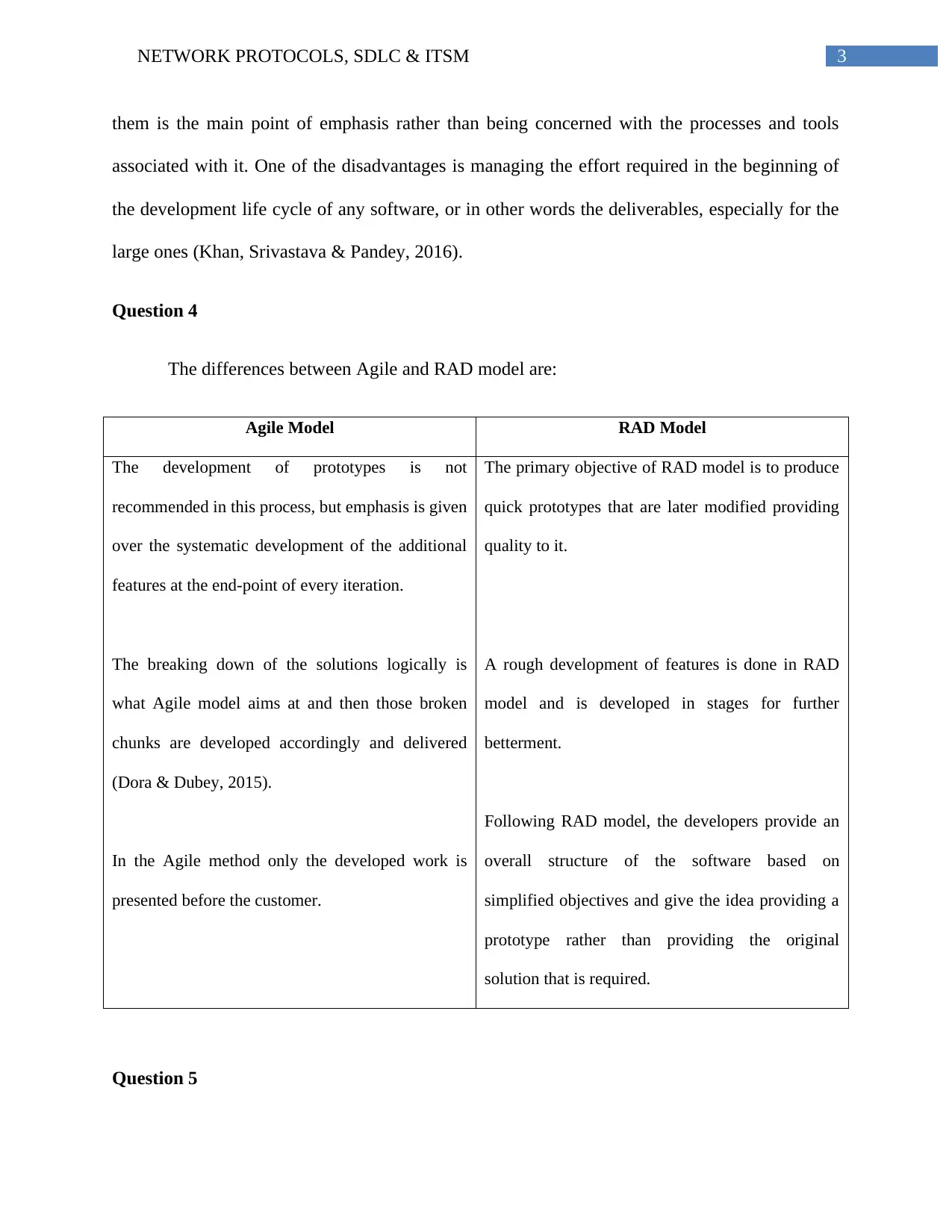
3NETWORK PROTOCOLS, SDLC & ITSM
them is the main point of emphasis rather than being concerned with the processes and tools
associated with it. One of the disadvantages is managing the effort required in the beginning of
the development life cycle of any software, or in other words the deliverables, especially for the
large ones (Khan, Srivastava & Pandey, 2016).
Question 4
The differences between Agile and RAD model are:
Agile Model RAD Model
The development of prototypes is not
recommended in this process, but emphasis is given
over the systematic development of the additional
features at the end-point of every iteration.
The breaking down of the solutions logically is
what Agile model aims at and then those broken
chunks are developed accordingly and delivered
(Dora & Dubey, 2015).
In the Agile method only the developed work is
presented before the customer.
The primary objective of RAD model is to produce
quick prototypes that are later modified providing
quality to it.
A rough development of features is done in RAD
model and is developed in stages for further
betterment.
Following RAD model, the developers provide an
overall structure of the software based on
simplified objectives and give the idea providing a
prototype rather than providing the original
solution that is required.
Question 5
them is the main point of emphasis rather than being concerned with the processes and tools
associated with it. One of the disadvantages is managing the effort required in the beginning of
the development life cycle of any software, or in other words the deliverables, especially for the
large ones (Khan, Srivastava & Pandey, 2016).
Question 4
The differences between Agile and RAD model are:
Agile Model RAD Model
The development of prototypes is not
recommended in this process, but emphasis is given
over the systematic development of the additional
features at the end-point of every iteration.
The breaking down of the solutions logically is
what Agile model aims at and then those broken
chunks are developed accordingly and delivered
(Dora & Dubey, 2015).
In the Agile method only the developed work is
presented before the customer.
The primary objective of RAD model is to produce
quick prototypes that are later modified providing
quality to it.
A rough development of features is done in RAD
model and is developed in stages for further
betterment.
Following RAD model, the developers provide an
overall structure of the software based on
simplified objectives and give the idea providing a
prototype rather than providing the original
solution that is required.
Question 5
Paraphrase This Document
Need a fresh take? Get an instant paraphrase of this document with our AI Paraphraser
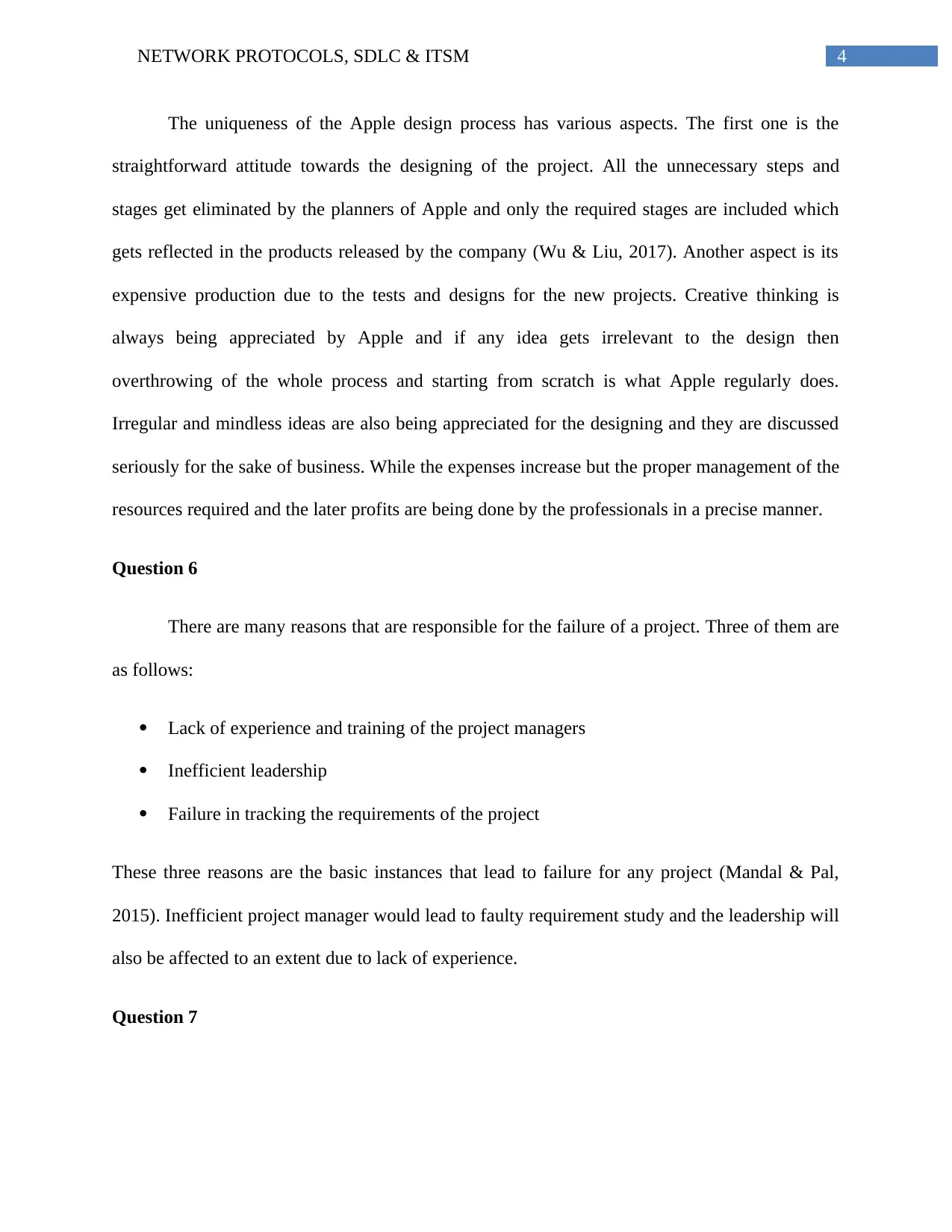
4NETWORK PROTOCOLS, SDLC & ITSM
The uniqueness of the Apple design process has various aspects. The first one is the
straightforward attitude towards the designing of the project. All the unnecessary steps and
stages get eliminated by the planners of Apple and only the required stages are included which
gets reflected in the products released by the company (Wu & Liu, 2017). Another aspect is its
expensive production due to the tests and designs for the new projects. Creative thinking is
always being appreciated by Apple and if any idea gets irrelevant to the design then
overthrowing of the whole process and starting from scratch is what Apple regularly does.
Irregular and mindless ideas are also being appreciated for the designing and they are discussed
seriously for the sake of business. While the expenses increase but the proper management of the
resources required and the later profits are being done by the professionals in a precise manner.
Question 6
There are many reasons that are responsible for the failure of a project. Three of them are
as follows:
Lack of experience and training of the project managers
Inefficient leadership
Failure in tracking the requirements of the project
These three reasons are the basic instances that lead to failure for any project (Mandal & Pal,
2015). Inefficient project manager would lead to faulty requirement study and the leadership will
also be affected to an extent due to lack of experience.
Question 7
The uniqueness of the Apple design process has various aspects. The first one is the
straightforward attitude towards the designing of the project. All the unnecessary steps and
stages get eliminated by the planners of Apple and only the required stages are included which
gets reflected in the products released by the company (Wu & Liu, 2017). Another aspect is its
expensive production due to the tests and designs for the new projects. Creative thinking is
always being appreciated by Apple and if any idea gets irrelevant to the design then
overthrowing of the whole process and starting from scratch is what Apple regularly does.
Irregular and mindless ideas are also being appreciated for the designing and they are discussed
seriously for the sake of business. While the expenses increase but the proper management of the
resources required and the later profits are being done by the professionals in a precise manner.
Question 6
There are many reasons that are responsible for the failure of a project. Three of them are
as follows:
Lack of experience and training of the project managers
Inefficient leadership
Failure in tracking the requirements of the project
These three reasons are the basic instances that lead to failure for any project (Mandal & Pal,
2015). Inefficient project manager would lead to faulty requirement study and the leadership will
also be affected to an extent due to lack of experience.
Question 7

5NETWORK PROTOCOLS, SDLC & ITSM
When several requirements are there to be met and also within a budget, then the primary
goals that need to be set in the first place is analysing the requirements and considering the
important stages while excluding the ones that will not affect the project, if skipped. Financial
allowance have to be controlled for the resources.
When several requirements are there to be met and also within a budget, then the primary
goals that need to be set in the first place is analysing the requirements and considering the
important stages while excluding the ones that will not affect the project, if skipped. Financial
allowance have to be controlled for the resources.
⊘ This is a preview!⊘
Do you want full access?
Subscribe today to unlock all pages.

Trusted by 1+ million students worldwide
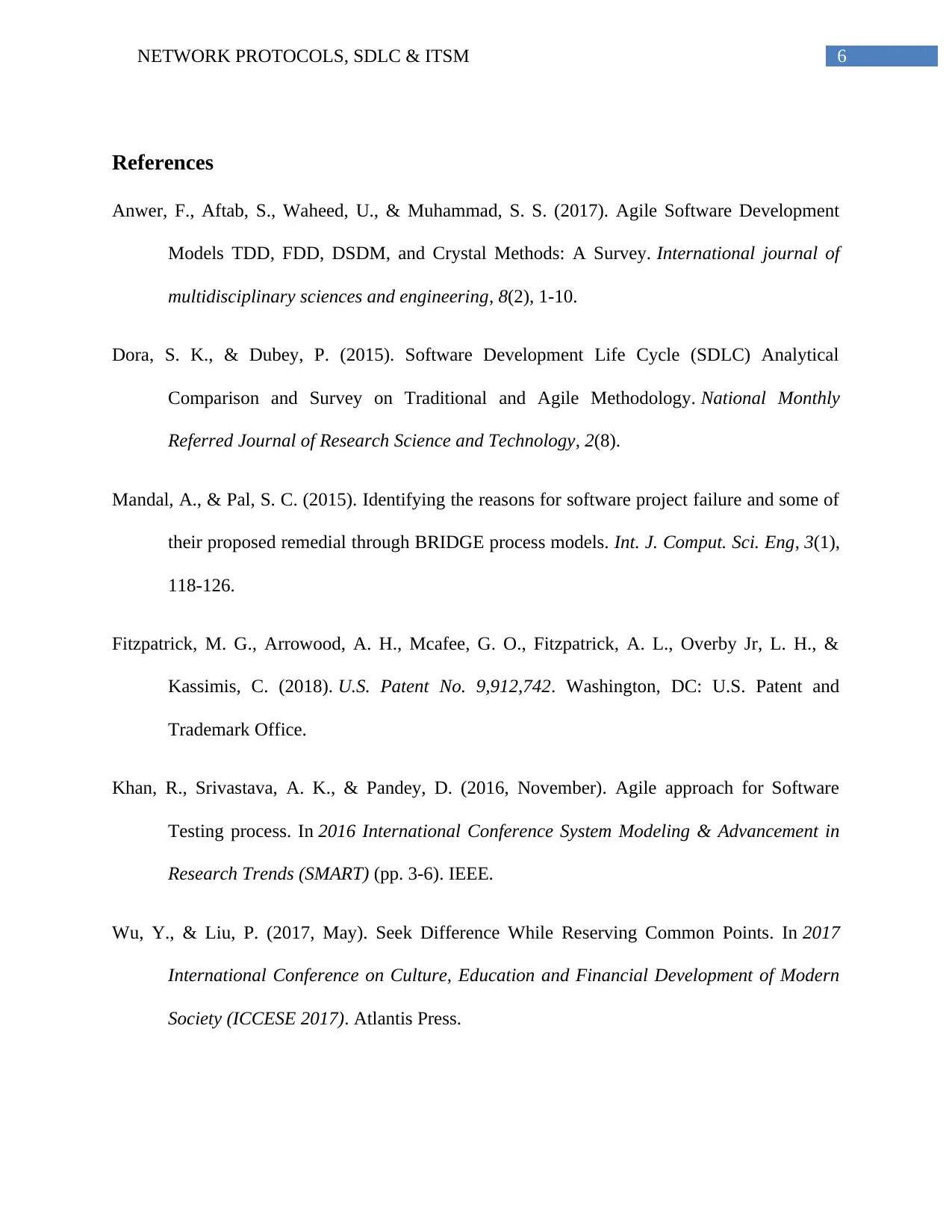
6NETWORK PROTOCOLS, SDLC & ITSM
References
Anwer, F., Aftab, S., Waheed, U., & Muhammad, S. S. (2017). Agile Software Development
Models TDD, FDD, DSDM, and Crystal Methods: A Survey. International journal of
multidisciplinary sciences and engineering, 8(2), 1-10.
Dora, S. K., & Dubey, P. (2015). Software Development Life Cycle (SDLC) Analytical
Comparison and Survey on Traditional and Agile Methodology. National Monthly
Referred Journal of Research Science and Technology, 2(8).
Mandal, A., & Pal, S. C. (2015). Identifying the reasons for software project failure and some of
their proposed remedial through BRIDGE process models. Int. J. Comput. Sci. Eng, 3(1),
118-126.
Fitzpatrick, M. G., Arrowood, A. H., Mcafee, G. O., Fitzpatrick, A. L., Overby Jr, L. H., &
Kassimis, C. (2018). U.S. Patent No. 9,912,742. Washington, DC: U.S. Patent and
Trademark Office.
Khan, R., Srivastava, A. K., & Pandey, D. (2016, November). Agile approach for Software
Testing process. In 2016 International Conference System Modeling & Advancement in
Research Trends (SMART) (pp. 3-6). IEEE.
Wu, Y., & Liu, P. (2017, May). Seek Difference While Reserving Common Points. In 2017
International Conference on Culture, Education and Financial Development of Modern
Society (ICCESE 2017). Atlantis Press.
References
Anwer, F., Aftab, S., Waheed, U., & Muhammad, S. S. (2017). Agile Software Development
Models TDD, FDD, DSDM, and Crystal Methods: A Survey. International journal of
multidisciplinary sciences and engineering, 8(2), 1-10.
Dora, S. K., & Dubey, P. (2015). Software Development Life Cycle (SDLC) Analytical
Comparison and Survey on Traditional and Agile Methodology. National Monthly
Referred Journal of Research Science and Technology, 2(8).
Mandal, A., & Pal, S. C. (2015). Identifying the reasons for software project failure and some of
their proposed remedial through BRIDGE process models. Int. J. Comput. Sci. Eng, 3(1),
118-126.
Fitzpatrick, M. G., Arrowood, A. H., Mcafee, G. O., Fitzpatrick, A. L., Overby Jr, L. H., &
Kassimis, C. (2018). U.S. Patent No. 9,912,742. Washington, DC: U.S. Patent and
Trademark Office.
Khan, R., Srivastava, A. K., & Pandey, D. (2016, November). Agile approach for Software
Testing process. In 2016 International Conference System Modeling & Advancement in
Research Trends (SMART) (pp. 3-6). IEEE.
Wu, Y., & Liu, P. (2017, May). Seek Difference While Reserving Common Points. In 2017
International Conference on Culture, Education and Financial Development of Modern
Society (ICCESE 2017). Atlantis Press.
1 out of 7
Related Documents
Your All-in-One AI-Powered Toolkit for Academic Success.
+13062052269
info@desklib.com
Available 24*7 on WhatsApp / Email
![[object Object]](/_next/static/media/star-bottom.7253800d.svg)
Unlock your academic potential
© 2024 | Zucol Services PVT LTD | All rights reserved.





